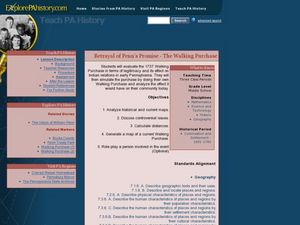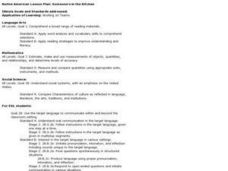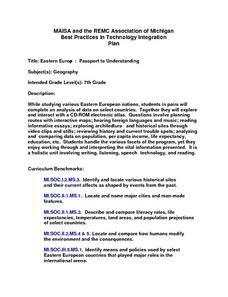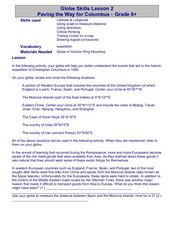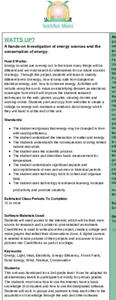Curated OER
From Molecules to Mole Day Do's
Students recognize methods used to define the mole. After converting various quantities to the mole, students provide a context for understanding the usefulness of scientific notation and the mole.
Curated OER
Betrayal of Penn's Promise - The Walking Purchase
Pupils role-play the 1737 Walking Purchase. In this Pennsylvania history lesson, students role-play the 1737 Walking Purchase and analyze its effects. Pupils also consider how it would affect their community today.
Curated OER
Native American Lesson Plan: Someone's in the Kitchen
Learners use vocabulary necessary to complete cooking activities and tell others about the food. They discuss similarities and differences between Native American and other nationalities' foods made in their families.
Curated OER
Babylonian Mathematics 2
Students research Babylonian mathematics. They calculate simple surd numbers. Students find the fractional form of rational numbers expressed as decimals. They work with numbers in base 60.
Curated OER
Waddle You Know About Penguins
Second graders study the similarities and differences of the seventeen species of penguins. They investigate habitats and how these habitats are suited to each species characteristics. They see how animals adapt to their environments.
Curated OER
Eastern Europe: Passport to Understanding
Seventh graders explore Eastern Europe. They analyze data on select countries. Students prepare a short oral presentation on the country they researched. They locate their country using an interactive map.
Curated OER
Naviagational Tools
Fifth graders create a compass, with the help of written instructions and then write six sentences discussing how compasses work and why they are helpful. They discuss the different types of navigational tools and how they are helpful.
Curated OER
Understanding Zoning: Its use on the High Line in West Chelsea
High schoolers are introduced to zoning. Evaluating information and reading a land-use map is enclosed in this lesson. List new development projects that they could propose for a given area.
Curated OER
One Plus One Makes New
Students discover the properties of matter and how they change when composite materials are produced. In this informative lesson plan students write up a question and procedure to an experiment then analyze and draw conclusions...
Curated OER
A Line Drive
Eleventh graders create a 100 year timeline centering on the life of their research subject and place them in the context of local and national history.
Curated OER
Text as Texture Collage
Pupils explore the concepts of rhythm, movement, contrast and texture. They practice using new vocabulary and work on creating a college after designing the arrangement. They self-evaluate their collage and critique their classmates...
Curated OER
Time Conceptualization
Students relate the number and length of generations in their living family members to the number of generations that have passed since specific events in recorded history. They then apply this time conceptualization to the number of...
Curated OER
Lesson plan: Archaeology - Its Methods and Use
High schoolers study the field of archeology. In this archeology instructional activity, students participate in 12 activities that require them to examine archeology, garbology, artifacts, ethical issues, and field specific vocabulary.
Curated OER
Globe Skills Lesson 2: Paving the Way for Columbus
Students explore the expedition of Christopher Columbus. In this geography skills lesson, students consider the technological advances that made Columbus's expedition possible as they complete a latitude and longitude activity.
Curated OER
Immigration and Settlement of Ethnic Groups in the Pacific Northwest
Students examine ethnic history of the Pacific Northwest in the period 1850-1950. They research documents and images in digital archives to explore immigration of various ethnic groups that settled in the region during this period.
Curated OER
Mexican-Americans: Yesterday, Today and Tomorrow
Students examine how the Mexican-American culture developed in Los Angeles. They explore the past, present and future of Mexican-Americans in LA and present their findings in a PowerPoint presentation.
Curated OER
Institution vs. Individuals
Students examine and evaluate how the U.S. government dealt with the Native American populations during westward expansion. They complete a class KWL chart, take notes during a teacher-led lecture. Students read about the Battle at...
Curated OER
WATTS UP?
Second graders research the Internet as they classify different forms of energy, investigate electrical energy and how to conserve energy.
Curated OER
Comparing Time Periods in U.S. History: The Ashford Project
Fifth graders use a "fact book" comparing periods in American history then students create a picture to illustrate their assigned periods. # # students use their pictures and concept maps to write expository paragraphs about their...
Curated OER
Confederation II : the Sequel
Learners examine the dynamics and challenges of creating a system of government that meet the needs of a changing, diverse population, for a new country. This is a nice simulation/role play of the formation of government.
Curated OER
Exploring the Celestial Neighborhood
Ninth graders study the origin and organization of the solar system. They investigate the Earth's place in the system and how planetary motions explain natural phenomena observable from Earth.
Curated OER
Timeline of Yellowstone History
Learners research important dates and events in the history and development of Yellowstone National Park. They create a timeline that denotes the events after watching the associated video clips.
Curated OER
Mirror, Mirror
Pupils examine portraits done by Robert Harris and discuss the technique he used to create them. With a partner, they paint a picture of each other using the techniques of Harris. They also make a drawing of themselves from a recent...
Science Education Resource Center at Carleton College
Serc: Geo Logic: Continental Drift and Plate Tectonics
Using the skills of a paleontologist, students are asked to match up lecturers with what day and time they teach, and how many students they have based on clues given from several different perspectives. In the second part of the...

